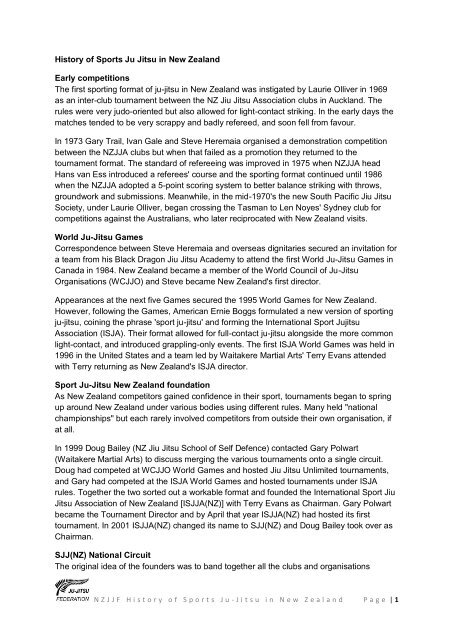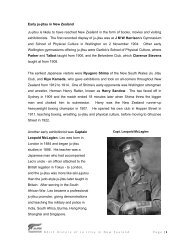history of sport ju-jitsu in New Zealand - New Zealand Ju-Jitsu ...
history of sport ju-jitsu in New Zealand - New Zealand Ju-Jitsu ...
history of sport ju-jitsu in New Zealand - New Zealand Ju-Jitsu ...
You also want an ePaper? Increase the reach of your titles
YUMPU automatically turns print PDFs into web optimized ePapers that Google loves.
History <strong>of</strong> Sports <strong>Ju</strong> <strong>Jitsu</strong> <strong>in</strong> <strong>New</strong> <strong>Zealand</strong><br />
Early competitions<br />
The first <strong>sport</strong><strong>in</strong>g format <strong>of</strong> <strong>ju</strong>-<strong>jitsu</strong> <strong>in</strong> <strong>New</strong> <strong>Zealand</strong> was <strong>in</strong>stigated by Laurie Olliver <strong>in</strong> 1969<br />
as an <strong>in</strong>ter-club tournament between the NZ Jiu <strong>Jitsu</strong> Association clubs <strong>in</strong> Auckland. The<br />
rules were very <strong>ju</strong>do-oriented but also allowed for light-contact strik<strong>in</strong>g. In the early days the<br />
matches tended to be very scrappy and badly refereed, and soon fell from favour.<br />
In 1973 Gary Trail, Ivan Gale and Steve Heremaia organised a demonstration competition<br />
between the NZJJA clubs but when that failed as a promotion they returned to the<br />
tournament format. The standard <strong>of</strong> referee<strong>in</strong>g was improved <strong>in</strong> 1975 when NZJJA head<br />
Hans van Ess <strong>in</strong>troduced a referees' course and the <strong>sport</strong><strong>in</strong>g format cont<strong>in</strong>ued until 1986<br />
when the NZJJA adopted a 5-po<strong>in</strong>t scor<strong>in</strong>g system to better balance strik<strong>in</strong>g with throws,<br />
groundwork and submissions. Meanwhile, <strong>in</strong> the mid-1970's the new South Pacific Jiu <strong>Jitsu</strong><br />
Society, under Laurie Olliver, began cross<strong>in</strong>g the Tasman to Len Noyes' Sydney club for<br />
competitions aga<strong>in</strong>st the Australians, who later reciprocated with <strong>New</strong> <strong>Zealand</strong> visits.<br />
World <strong>Ju</strong>-<strong>Jitsu</strong> Games<br />
Correspondence between Steve Heremaia and overseas dignitaries secured an <strong>in</strong>vitation for<br />
a team from his Black Dragon Jiu <strong>Jitsu</strong> Academy to attend the first World <strong>Ju</strong>-<strong>Jitsu</strong> Games <strong>in</strong><br />
Canada <strong>in</strong> 1984. <strong>New</strong> <strong>Zealand</strong> became a member <strong>of</strong> the World Council <strong>of</strong> <strong>Ju</strong>-<strong>Jitsu</strong><br />
Organisations (WCJJO) and Steve became <strong>New</strong> <strong>Zealand</strong>'s first director.<br />
Appearances at the next five Games secured the 1995 World Games for <strong>New</strong> <strong>Zealand</strong>.<br />
However, follow<strong>in</strong>g the Games, American Ernie Boggs formulated a new version <strong>of</strong> <strong>sport</strong><strong>in</strong>g<br />
<strong>ju</strong>-<strong>jitsu</strong>, co<strong>in</strong><strong>in</strong>g the phrase '<strong>sport</strong> <strong>ju</strong>-<strong>jitsu</strong>' and form<strong>in</strong>g the International Sport <strong>Ju</strong><strong>jitsu</strong><br />
Association (ISJA). Their format allowed for full-contact <strong>ju</strong>-<strong>jitsu</strong> alongside the more common<br />
light-contact, and <strong>in</strong>troduced grappl<strong>in</strong>g-only events. The first ISJA World Games was held <strong>in</strong><br />
1996 <strong>in</strong> the United States and a team led by Waitakere Martial Arts' Terry Evans attended<br />
with Terry return<strong>in</strong>g as <strong>New</strong> <strong>Zealand</strong>'s ISJA director.<br />
Sport <strong>Ju</strong>-<strong>Jitsu</strong> <strong>New</strong> <strong>Zealand</strong> foundation<br />
As <strong>New</strong> <strong>Zealand</strong> competitors ga<strong>in</strong>ed confidence <strong>in</strong> their <strong>sport</strong>, tournaments began to spr<strong>in</strong>g<br />
up around <strong>New</strong> <strong>Zealand</strong> under various bodies us<strong>in</strong>g different rules. Many held "national<br />
championships" but each rarely <strong>in</strong>volved competitors from outside their own organisation, if<br />
at all.<br />
In 1999 Doug Bailey (NZ Jiu <strong>Jitsu</strong> School <strong>of</strong> Self Defence) contacted Gary Polwart<br />
(Waitakere Martial Arts) to discuss merg<strong>in</strong>g the various tournaments onto a s<strong>in</strong>gle circuit.<br />
Doug had competed at WCJJO World Games and hosted Jiu <strong>Jitsu</strong> Unlimited tournaments,<br />
and Gary had competed at the ISJA World Games and hosted tournaments under ISJA<br />
rules. Together the two sorted out a workable format and founded the International Sport Jiu<br />
<strong>Jitsu</strong> Association <strong>of</strong> <strong>New</strong> <strong>Zealand</strong> [ISJJA(NZ)] with Terry Evans as Chairman. Gary Polwart<br />
became the Tournament Director and by April that year ISJJA(NZ) had hosted its first<br />
tournament. In 2001 ISJJA(NZ) changed its name to SJJ(NZ) and Doug Bailey took over as<br />
Chairman.<br />
SJJ(NZ) National Circuit<br />
The orig<strong>in</strong>al idea <strong>of</strong> the founders was to band together all the clubs and organisations<br />
N Z J J F H i s t o r y o f S p o r t s J u - J i t s u i n N e w Z e a l a n d P a g e | 1
unn<strong>in</strong>g their own tournaments and "national championships" and to put those tournaments<br />
onto one circuit that was open to all martial artists, regardless <strong>of</strong> style. The hope was to<br />
create more unity <strong>in</strong> the <strong>ju</strong>-<strong>jitsu</strong> and wider martial arts community, develop <strong>New</strong> <strong>Zealand</strong><br />
standards by allow<strong>in</strong>g competitors to amass greater experience, and to determ<strong>in</strong>e, by an<br />
open process, <strong>ju</strong>st who the top competitors <strong>in</strong> this country were. Orig<strong>in</strong>ally, the National<br />
Circuit was made up <strong>of</strong> tournaments hosted by separate clubs, each run under the particular<br />
rules <strong>of</strong> the host club, with SJJ(NZ) oversee<strong>in</strong>g the adm<strong>in</strong>istration <strong>of</strong> entries, draws, referees<br />
and rank<strong>in</strong>g results. The diversity <strong>of</strong> rules was seen as a positive factor <strong>in</strong> develop<strong>in</strong>g the<br />
mental flexibility needed by NZ <strong>in</strong>ternational competitors, but as time progressed SJJ(NZ)<br />
took a greater role <strong>in</strong> runn<strong>in</strong>g the tournaments, and at competitors' request, the rules were<br />
standardised <strong>in</strong>to a s<strong>in</strong>gle format for all tournaments.<br />
Rules<br />
The rules <strong>of</strong> the tournaments for the first two years were those <strong>of</strong> the host organisations and<br />
were categorized <strong>in</strong>to Freefight<strong>in</strong>g, Grappl<strong>in</strong>g and Self Defence. Some Freefight<strong>in</strong>g rules<br />
allowed for strik<strong>in</strong>g to the face and thigh kicks, while others made those illegal but allowed<br />
w<strong>in</strong> by submission as well as w<strong>in</strong> by most po<strong>in</strong>ts. Weight divisions were standardized with<br />
six men's divisions from Under 70kg to 110kg+ and three women's divisions from Under<br />
60kg to 70kg+. Part way through 2000, Colts (Under 18) divisions were added and<br />
competition from 2002 onwards <strong>in</strong>cluded children's (Under 15) divisions.<br />
In 2001 rules at all SJJ(NZ) tournaments were standardized. Freefight<strong>in</strong>g allowed one po<strong>in</strong>t<br />
to be scored for any type <strong>of</strong> strike to legal targets above the knees but actual contact to the<br />
face was disallowed although non-contact strikes were scored. Throws and takedowns were<br />
scored accord<strong>in</strong>g to classification, and groundfight<strong>in</strong>g was scored by p<strong>in</strong>s, with submissions<br />
be<strong>in</strong>g awarded po<strong>in</strong>ts and a restart from the mount. Grappl<strong>in</strong>g was standardized <strong>in</strong>to a s<strong>in</strong>gle<br />
format that reflected good grappl<strong>in</strong>g strategy and which awarded po<strong>in</strong>ts that were fair to <strong>ju</strong>do<br />
players at one extreme and Brazilian jiu <strong>jitsu</strong> competitors at the other.<br />
That same year, a Strik<strong>in</strong>g category that resembled light-contact karate / tae kwon do was<br />
<strong>in</strong>troduced to try to attract more competitors from strik<strong>in</strong>g arts. However, few additional clubs<br />
were coaxed <strong>in</strong>to attend<strong>in</strong>g and the focus on strik<strong>in</strong>g-only <strong>in</strong> the Strik<strong>in</strong>g category saw a<br />
number <strong>of</strong> heated clashes. By the end <strong>of</strong> 2002 a disqualification and discipl<strong>in</strong>ary procedure<br />
was implemented to curb the excess contact, and Strik<strong>in</strong>g was dropped for the 2003 season,<br />
never to appear aga<strong>in</strong>. At the same time, a re-look at Freefight<strong>in</strong>g <strong>in</strong> 2002 saw groundfight<strong>in</strong>g<br />
time-limits extended from 30 seconds to 45 seconds, and strik<strong>in</strong>g allowed on the<br />
ground.<br />
<strong>New</strong> <strong>Zealand</strong> Black Tops<br />
By 2000 over 30 clubs had competed on the SJJ(NZ) National Circuit and later that year a<br />
team <strong>of</strong> athletes were chosen to represent <strong>New</strong> <strong>Zealand</strong> at the ISJA World Sport <strong>Ju</strong>-<strong>Jitsu</strong><br />
Games <strong>in</strong> England. The significance <strong>of</strong> this team was that it was the first to have been<br />
chosen objectively from the country's pool <strong>of</strong> <strong>sport</strong> <strong>ju</strong>-<strong>jitsu</strong> competitors, each team member<br />
hold<strong>in</strong>g a number one rank<strong>in</strong>g, and hav<strong>in</strong>g the most specialised competition preparation to<br />
date. The team <strong>of</strong> eight returned from Leeds with two gold medals, four silver, and a bronze,<br />
easily the most impressive results <strong>of</strong> the 10 NZ teams to have attended World Games s<strong>in</strong>ce<br />
1984.<br />
N Z J J F H i s t o r y o f S p o r t s J u - J i t s u i n N e w Z e a l a n d P a g e | 2
At the 2002 ISJA World Games <strong>in</strong> South Africa, <strong>ju</strong>st two Black Tops represented <strong>New</strong><br />
<strong>Zealand</strong>, return<strong>in</strong>g with two gold medals and one silver. <strong>New</strong> <strong>Zealand</strong> had no show<strong>in</strong>g at the<br />
2004 Games, but <strong>in</strong> 2006 four Black Tops attended the ISJA World Games <strong>in</strong> Argent<strong>in</strong>a,<br />
return<strong>in</strong>g with one gold medal and two silvers.<br />
Sport <strong>Ju</strong>-<strong>Jitsu</strong> Black Belts<br />
The SJJ(NZ) Black Belt was designed to reward those competitors who complete 50 w<strong>in</strong>s on<br />
the SJJ(NZ) National Circuit. The first recipient <strong>of</strong> this outstand<strong>in</strong>g achievement was Louise<br />
Park, <strong>in</strong> 2000. To date, <strong>ju</strong>st eight awards have been made. In 2006 Neil Swailes made<br />
<strong>history</strong> by achiev<strong>in</strong>g the momentous milestone <strong>of</strong> 100 match w<strong>in</strong>s.<br />
National Championships<br />
In 2001 SJJ(NZ) took the next step <strong>of</strong> add<strong>in</strong>g a National Championship to the National<br />
Circuit <strong>in</strong> order to f<strong>in</strong>d the best competitors <strong>in</strong> <strong>New</strong> <strong>Zealand</strong>, <strong>in</strong> addition to those hold<strong>in</strong>g top<br />
rank<strong>in</strong>gs on the circuit. By the end <strong>of</strong> the Nationals over 35 clubs had competed at SJJ(NZ)<br />
tournaments.<br />
Referees' Programme<br />
The first systematic tra<strong>in</strong><strong>in</strong>g <strong>of</strong> referees had been <strong>in</strong>stigated by Hans van Ess <strong>in</strong> 1975, and <strong>in</strong><br />
1992 Steve Heremaia had some <strong>of</strong> his members ga<strong>in</strong> qualifications under WCJJO. Doug<br />
Bailey was one such WCJJO referee and, together with Gary Polwart, he developed the<br />
SJJ(NZ) Referees' Programme to recruit and tra<strong>in</strong> referees for the SJJ(NZ) National Circuit.<br />
The new Referees' Programme standardised the different qualities <strong>of</strong> expertise <strong>in</strong> <strong>New</strong><br />
<strong>Zealand</strong> at the time and assessed current referees to one <strong>of</strong> three levels. All referees were<br />
retra<strong>in</strong>ed to a new standard and new entrants were prepared <strong>in</strong> the theory <strong>of</strong> referee<strong>in</strong>g and<br />
then given the opportunity to ga<strong>in</strong> qualifications by ga<strong>in</strong><strong>in</strong>g experience on the mat. Under the<br />
current programme, Class III referees may time-keep, score-keep and score matches as<br />
<strong>Ju</strong>dges. Class II referees may centre referee, and Class I referees may referee at<br />
<strong>in</strong>ternational level and tra<strong>in</strong> others <strong>in</strong> the programme.<br />
Restructure<br />
August 2003 saw the foundation <strong>of</strong> the <strong>New</strong> <strong>Zealand</strong> <strong>Ju</strong>-<strong>Jitsu</strong> Federation. Much <strong>of</strong> the<br />
success <strong>of</strong> the Federation was due to the accomplishments <strong>of</strong> SJJ(NZ), and <strong>in</strong> form<strong>in</strong>g the<br />
Federation, SJJ(NZ) allowed itself to be absorbed as a sub-branch <strong>of</strong> NZJJF. With the<br />
restructure <strong>of</strong> NZJJF <strong>in</strong> 2005, the SJJ(NZ) committee was disbanded <strong>in</strong> favour <strong>of</strong> a CEO<br />
represent<strong>in</strong>g SJJ(NZ) on the NZJJF committee. Rowena Haper became the first SJJ(NZ)<br />
CEO.<br />
N Z J J F H i s t o r y o f S p o r t s J u - J i t s u i n N e w Z e a l a n d P a g e | 3



